Author: Alex Thorn, Head of Research, Galaxy Digital; Translation: @Jinse Finance xz
In the third quarter of 2025, venture capital activity in the cryptocurrency sector remained subdued compared to previous bull market levels. While there was some growth from the previous quarter, this was primarily driven by a few late-stage deals. Valuations have risen to bull market levels, while early-stage investment activity remained active. The macroeconomic environment continues to weigh on fund managers seeking new allocations, and the recent fourth-quarter crypto market activity is likely to further hinder allocations in the fourth quarter of this year and the first quarter of 2026. Competition from investment vehicles such as ETFs and digital asset treasury companies has further exacerbated the headwinds.
While still below the 2021-2022 bull market levels, venture capital activity overall remained active and healthy. Sectors such as stablecoins, artificial intelligence, blockchain infrastructure, and trading continued to attract deals and funding, and pre-seed round investment activity remained stable.
Given the new administration's commitment to promoting the adoption of Bitcoin, cryptocurrencies, and blockchain technology, the United States' long-standing dominance in this field is likely to be further strengthened. In the third quarter of 2025, total venture capital investment in cryptocurrency startups reached $4.59 billion (a 59% decrease quarter-over-quarter), with 414 deals (a 15% decrease quarter-over-quarter). Late-stage deals accounted for 56% of total investment, while early-stage deals accounted for 44%. Deal-based projects, with $2.1 billion in funding, were the most favored sector for venture capital, including Revolut which raised $1 billion and Kraken which raised $500 million. The US once again dominated in terms of funding size and number of deals. In terms of fundraising, investors allocated $3.16 billion to 13 new crypto venture capital funds. (1) Number and Amount of Investments In the third quarter, venture capital firms invested a total of $4.65 billion in startups and private companies in the cryptocurrency and blockchain sector (a 290% increase quarter-over-quarter), with 415 investments (a 9% increase quarter-over-quarter). In the third quarter, seven investments accounted for half of the total venture capital investment in the cryptocurrency and blockchain sector: Revolut ($1 billion), Kraken ($500 million), Erebor ($250 million), Treasury ($146 million), Fnality ($135 million), Mesh Connect ($130 million), and ZeroHash ($104 million). Looking at the annual data, although the number of investments did not exceed that of previous years, the total investment amount in the first three quarters of 2025 has already surpassed the same period in 2023 and 2024.
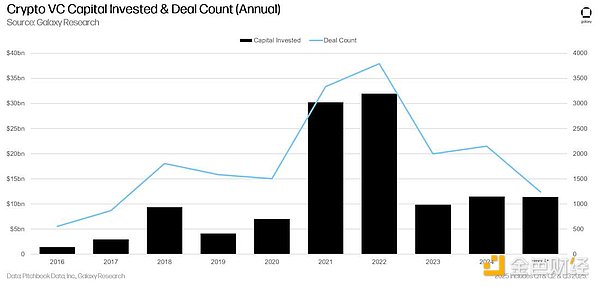
(2)Investment Amount and Bitcoin Price
In past cycles, investment in crypto startups was highly correlated with the price of Bitcoin. However, this cycle is different. Since January 2023, the price of Bitcoin has risen sharply, but venture capital activity has failed to keep pace. Weak interest from investors in crypto VC and the VC space as a whole, coupled with competition from public market instruments such as ETFs and treasury companies, has continued to divert funds that could have flowed to startups.
In the third quarter of 2025, 57% of funds were invested in mature companies, and 43% of funds flowed into growth companies. In terms of deal volume, the proportion of pre-seed round deals remained flat quarter-over-quarter and remains at a healthy level compared to previous cycles. We assess the activity level of startups by tracking the proportion of pre-seed round deals. Over the past few quarters, the proportion of later-stage deals has continued to rise, reflecting an overall increase in market maturity.
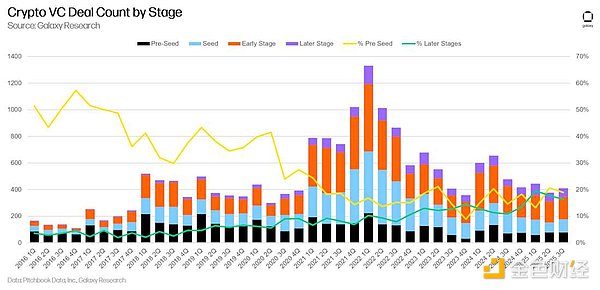
(3)Valuation and Transaction Size
Valuations of venture-backed crypto companies continued to rise in 2025, exceeding the 2021 high in the first quarter and approaching that level in the third quarter. The overall venture capital market valuation also increased in 2025, but has not yet reached the 2021 peak. The median transaction size in the crypto sector also hit a record high in the third quarter of 2025, with a median deal size of $4.5 million and a median pre-funding valuation of $36 million.
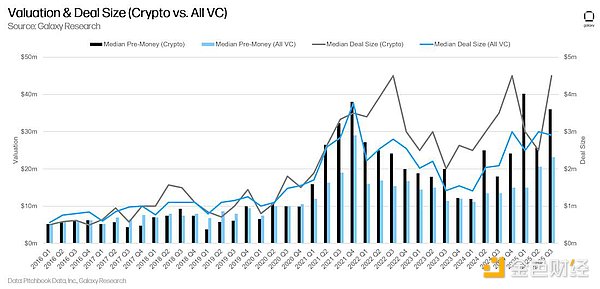
(4) Investment Category Analysis
In our classification system, trading/exchange/investment/lending companies raised the most funds from crypto venture capital firms, regaining the top spot with over $2 billion in funding. Revolut received $1 billion and Kraken received $500 million. This type of business possesses the most mature business model in the crypto space and has historically accounted for the largest share of venture capital allocations.

In the long run, the market share of funding in various sectors has shown some interesting trends beyond the continued dominance of the "trading/exchange/investment/lending" category. For example, the share of the Web3/NFT/DAO/metaverse/gaming category has declined since its peak during the PFP era, while the payment/rewards and banking categories have shown an upward trend.
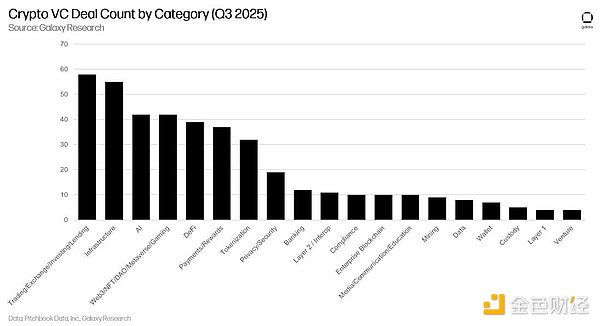
In terms of transaction volume, investment in this sector is becoming more diversified over time.

(5) Investment Stage and Category Analysis
Investment amounts and transaction volumes categorized by type and stage provide a clearer picture of which development stages of companies within each category are raising funds. In the third quarter of 2025, the vast majority of funds invested in the "Trading/Exchange/Investment/Lending" category flowed to mature-stage companies (primarily Revolut and Kraken). In contrast, financing entities in categories such as banking were mainly growth-stage companies. By analyzing the distribution of investment capital at different stages within each category, the relative maturity of various investment opportunities can be revealed. As with previous quarters, the major investment categories in the third quarter of 2025 exhibited healthy diversification in terms of transaction phases. By analyzing the proportion of transactions at different stages within each category, we can gain insight into the development cycle of each investable category.
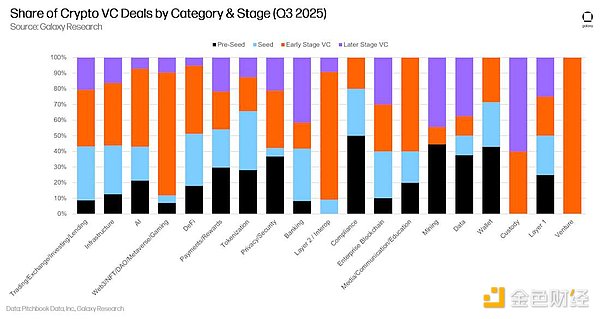
(6)Geographical Distribution of Investment
In the third quarter of 2025, 47% of investment funds flowed to companies headquartered in the United States. The United Kingdom ranked second with 28%, followed by Singapore (3.8%) and the Netherlands (3.3%).
In terms of transaction volume, the situation is largely similar but the distribution is slightly more dispersed. Companies headquartered in the United States completed 40% of the total transaction volume, followed by Singapore (7.3%), the United Kingdom (6.8%), and Hong Kong (3.6%).
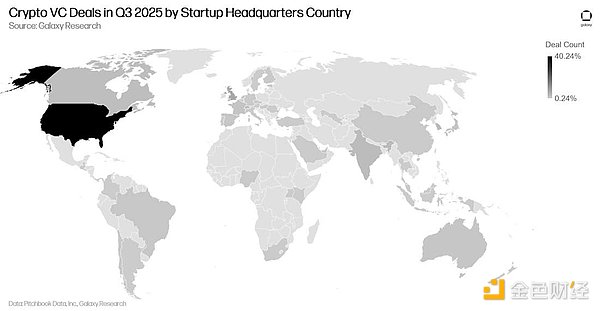
Looking at the founding year, companies founded in 2018 raised the most funds, while companies founded in 2024 received the most investments.

2、Venture Fund Raising Status
Despite a slight increase in total fundraising compared to the previous period, the fundraising environment for crypto venture funds remains challenging. The macroeconomic environment and the volatility in the crypto market in 2022-2023 continue to discourage some investors from maintaining their commitment to crypto venture investments from early 2021 to 2022. Recently, increased attention to artificial intelligence has also diverted some attention from crypto assets, while spot ETFs and treasury companies are also vying for institutional funds.
In the third quarter of 2025, venture capital funds focused on the crypto space raised a total of $3.16 billion across 16 funds. Looking at annual data, the total amount of funds raised by venture capital funds in the first three quarters of 2025 has already exceeded the total for 2024 and is expected to surpass the level of 2023.
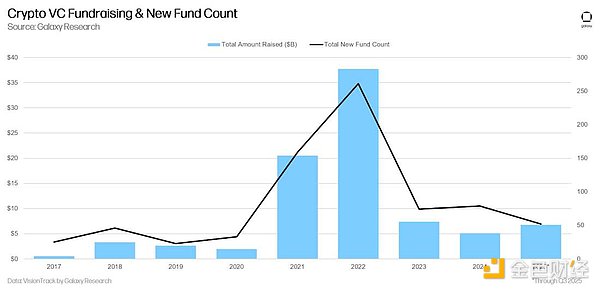
By 2025, the average size of venture capital funds has risen to $163 million, but the median size has fallen to $36 million.
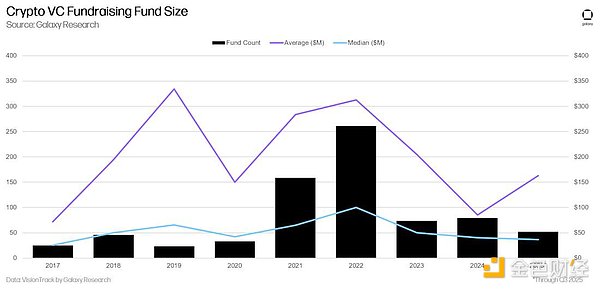
3. Summary
Market sentiment is improving and investment activity is increasing, but both are still well below historical highs. In the previous bull market cycles of 2017 and 2021, venture capital activity was highly correlated with the price of liquid crypto assets, but in the past two years, despite the rise in cryptocurrency prices, investment activity has remained sluggish. This stagnation in venture capital is caused by a variety of factors, such as the diminished appeal of previously popular crypto VC sectors (e.g., gaming, NFTs, and Web3); competition for investment funds from AI startups; and generally higher interest rates reducing the enthusiasm of venture capitalists. Mature companies will lead in funding size in 2025. Over the past three quarters, funding for mature companies has exceeded that for startups, reflecting the sector's increasing maturity. As the industry matures, the proportion of pre-seed round deals continues to decline. With crypto technology being adopted by established traditional institutions and many VC-backed companies achieving market fit, the golden age of pre-seed round venture capital in crypto may have passed. Spot ETPs (exchange-traded products) and digital asset treasury companies (DATCOs) may be putting pressure on funds and startups. Several high-profile investments by allocators in the US spot Bitcoin ETP sector suggest that some large investors (pension funds, endowments, hedge funds, etc.) may be gaining industry exposure through these large, highly liquid instruments, rather than turning to early-stage venture capital. Attention to spot Ethereum ETPs has increased over the past two quarters. If this trend continues, or if ETPs cover other alternative blockchain layers, demand for areas like DeFi or Web3 may flow to ETPs rather than the venture capital ecosystem. The rise of Digital Asset Treasury Companies (DATCOs) in 2025 may also compete with venture capital for allocator interest in this area. Fund managers still face a challenging environment. Although allocation funds increased slightly in 2025, the number of new funds declined for two consecutive quarters and remained near a five-year low. Macroeconomic trends continue to pose headwinds for allocators, but substantial changes in the regulatory environment may herald a resurgence in allocator interest in this sector. The US continues to dominate the crypto startup ecosystem. Despite an exceptionally complex and often hostile regulatory environment in recent years, US-based companies and projects have historically completed the majority of deals and received the most investment. This trend has continued this year as the new administration and Congress embark on the most pro-crypto agenda in history. We expect US dominance to strengthen, especially now that the GENIUS Act has been enacted, and further, if Congress passes a crypto market structure bill, it will attract substantial entry from traditional US financial services companies into the space.
 Alex
Alex















